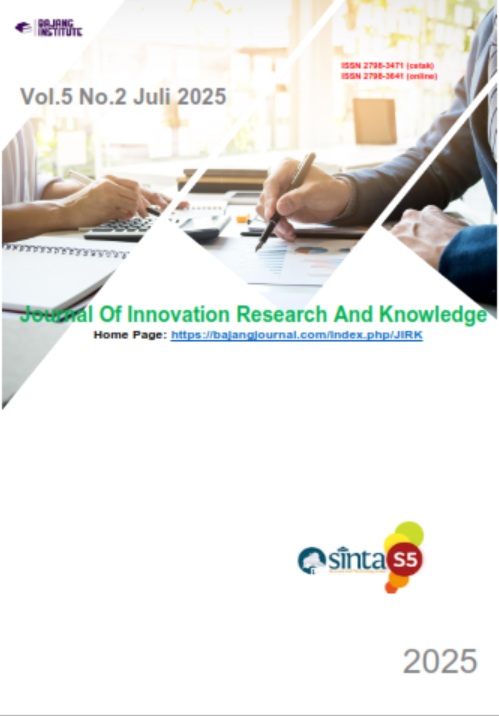THE COMMUNICATION STRATEGY OF THE TELEGRAM CHANNEL ‘KAZAKHS IN BALI’ THE ROLE OF DIGITAL MEDIA IN STRATEGIC CULTURAL COMMUNICATION AMONG DIASPORAS
DOI:
https://doi.org/10.53625/jirk.v5i2.10600Keywords:
Bali, Communication Strategy, Kazakh Community, S.O.M.E Model, TelegramAbstract
This study explores the communication strategy of the ‘Kazakh in Bali’ Telegram channel using the circular S.O.M.E (Share, Optimize, Manage, Engage) model as its theoretical framework. Through a qualitative approach, including interviews with the channel’s founder and content analysis, the research examines how the channel facilitates engagement and interaction within the Kazakhstani diaspora in Indonesia, particularly Bali. The findings reveal that the channel effectively shares relevant content, optimizes Telegram’s platform features, maintains organized management, and fosters member-led engagement, resulting in both virtual and real-world impacts. Activities initiated through the channel—such as cultural gatherings, domestic tourism, environmental volunteering, and charity work—not only strengthen community ties but also contribute positively to Indonesia. This research contributes to understanding how digital diaspora communities can serve as agents of cultural exchange and social contribution through strategic communication practices.
References
Agustini, A. (2023). Pengaruh Bauran Pemasaran Terhadap Volume Penjualan. Economics and Digital Business Review, 4(2), 113–127
Alexander, J. L., Safitri, D., & Anindhita, W. (2021). The circular model of SOME in Instagram management: Case study: Forum Human Capital Indonesia. Jurnal Komunikasi Indonesia, 8(1)
Alonso-Almeida, M.-d.-M., Borrajo-Millán, F., & Yi, L. (2019). Are social media data pushing overtourism? The case of Barcelona and Chinese tourists. Sustainability, 11(11), 3356
Anggito, S. &. (2018). Metodologi Penelitian Kualitatif. (E. D. Lestari, Ed.)
Ardiansah, I., & Maharani, A. (2020). Optimalisasi Instagram Sebagai Media Marketing. CV Cendekia Press.
Ardiansyah, A. (2023). Development of PAl Teaching Materials Based on Mind Mapping Model on Class Congregational Prayer Materials at SDN 2 Keniten. Social Science Academic, 1(1), 201-212
Ayu Retno Widyastuti, D., Beny Pramudyanto, A., & Noor Prima Astuti, R. A. V. (2018). Dinamika dalam Membangun Merek Kolektif pada Usaha Mikro, Kecil, dan Menengah. Komunikator, 10(2), 150–162
Bekreneva, J., & Solovyova, E. (2019). Features and prospects of the development of international tourism in the USA. Kazan Federal University.
Creswell, J. W. (2014). Research Design: Qualitative, Quantitative, and Mixed Methods Approaches. Thousand Oaks: Sage Publications
Hajati, R., Perbawasari, S., & Hafiar, H. (2018). Manajemen Aktivitas Media Sosial Akun Instagram @Indonesiabaik.Id. MetaCommunication: Journal Of Communication Studies, 3(2), 57–75.
Hu, M. (2022). Kazakhstan’s internet shutdown is the latest episode in an ominous trend: digital authoritarianism. The Conversation
Hung, V. V., Dey, S. K., Vaculcikova, Z., & Anh, L. T. H. (2021). The influence of tourists’ experience on destination loyalty: A case study of Hue City, Vietnam. Sustainability, 13(13), 8889
Kazakhstan Government. (2021). Culture of Kazakhstan. Gov.egov.kz
Kiráľová, A., & Pavlíček, A. (2015). Development of social media strategies in tourism destination. Procedia - Social and Behavioral Sciences, 175, 358-366
Lenaini, I. (2021). Teknik pengambilan sampel purposive dan snowball sampling. Jurnal Kajian, Penelitian & Pengambilan Pendidikan Sejarah, 6(1), 33-39
Lestari, Gita Tri. (2020). Strategi Komunikasi Pemasaran Disporaparbud Kabupaten Purwakarta Melalui Media Aplikasi Sampurasun Dalam Mempromosikan Pariwisata. Linimasa, 3, 81–100
Luttrell, R. (2015). Social Media. Rowman & Little Field
Luttrell, R. (2019). Social media: How to engage, share, and connect (3rd ed.). Rowman & Littlefield
Mcphead S (2011). Developing an internet marketing strategy. Internet marketing academy and Ventus publishing Aps.
Miles, Mattew B. dan A. Michael Huberman. (1992). Qualitative Data Analysis: A Sourcebook of New Method
Nasrullah. (2016). Media Sosial Perpektif Komunikasi, Budaya dan Sosioteknologi. Simbiosa Rekatama Media.
[22] Ordenes, F. V., Grewal, D., Ludwig, S., Ruyter, K. De, Mahr, D., & Wetzels, M. (2019). Cutting through Content Clutter: How speech and image acts drive consumer sharing of social media brand messages. Journal of Consumer Research, 45(5), 988–1012.
Prasanti, D. (2018). Penggunaan Media Komunikasi Bagi Remaja Perempuan Dalam Pencarian Informasi Kesehatan. Jurnal lontal, 6(1): 13-21
Putri, S. F. (2022). Manajemen Media Sosial Untuk Menjalin Hubungan Dengan Konsumen Di Pt Gama Multi Usaha Mandiri Selama Pandemi Covid-19
Qorib, F., Rinata, A. R., & Fianto, L. (2021). Analisis Customer Engagement pada Akun Instagram @Oksigen_Cafe Menggunakan The Circular Model of Some. Avant Garde, 9(2), 183.
Rahmayani, D., Oktavilia, S., Suseno, D. A., Isnaini, E. L., & Supriyadi, A. (2022). Tourism development and economic growth: An empirical investigation for Indonesia. Economics Development Analysis Journal, 1(1)
Rifai, N., & Kurniawan, T. (2023). The influence of economic growth, exchange rate, and inflation on foreign tourist visits to Indonesia. Journal of Socioeconomics and Development, 6(2), 128-137
Romdona, S., Junista, S. S., & Gunawan, A. (2025). Teknik pengumpulan data: observasi, wawancara dan kuesioner. jisosepol: Jurnal IImu Sosial Ekonomi Dan Politik, 3(1), 39-471
Sidiq, U., & Choiri, M. (2019). Metode Penelitian Kualitatif di Bidang Pendidikan. In CV Nata Karya (Vol. 53, Issue 9)
Sugiyono. (2013). Metode Penelitian Kuantitatif dan Kualitatif dan R & D. Bandung: Penerbit C.V Alfabeta. Sukabumi
Thomas, Laiby, & Bhat, Subramanya, (2022). A Comprehensive Overview of Telegram Services - A Case Study. International Journal of Case Studies in Business, IT, and Education (IJCSBE), 6(1), 288-301
Vartanian, T. P. (2010). Secondary Data Analysis. Oxford University Press
Werthner, H., & Ricci, F. (2004). E-commerce and tourism. Communications of the ACM, 47(12), 101-105
[34] Yin, R. K. (2009). Case study research: Design and methods (4th Ed.). Thousand Oaks, CA: Sage
Zakiyah, A. R., & Nofandrilla, N. (2022). Analysis of the circular model of SOME in the publication of PTPN XI Surabaya activities through Instagram. International Summit on Science Technology and Humanity (ISETH) 2022: Academic Improvement for Recovery Acceleration, 2477-3328, 2615-1588













